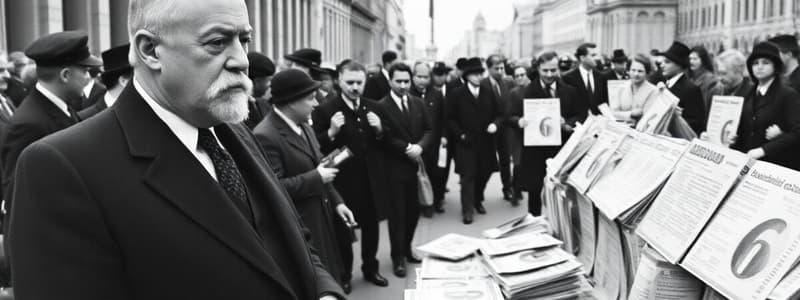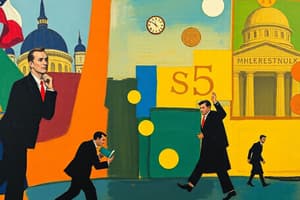Podcast
Questions and Answers
What triggered the hyperinflation crisis in Germany during the period of 1920-1923?
What triggered the hyperinflation crisis in Germany during the period of 1920-1923?
- Reparations payments imposed by the Treaty of Versailles and the Ruhr occupation (correct)
- Increased government spending on social welfare programs
- A decline in agricultural production due to drought
- A decrease in international trade due to global recession
The Weimar government's initial response to hyperinflation involved decreasing the money supply to stabilize the currency.
The Weimar government's initial response to hyperinflation involved decreasing the money supply to stabilize the currency.
False (B)
What currency was introduced to stabilize the German economy under Gustav Stresemann's leadership?
What currency was introduced to stabilize the German economy under Gustav Stresemann's leadership?
Rentenmark
The Dawes Plan of 1924 ______ reparations payments, contributing to the alleviation of the hyperinflation crisis.
The Dawes Plan of 1924 ______ reparations payments, contributing to the alleviation of the hyperinflation crisis.
What was a significant risk associated with Germany's economic recovery during the 'Golden Years' (1924-1929)?
What was a significant risk associated with Germany's economic recovery during the 'Golden Years' (1924-1929)?
Gustav Stresemann believed that the economic position of a nation was not directly related to its moral and political stability.
Gustav Stresemann believed that the economic position of a nation was not directly related to its moral and political stability.
Prior to his death in 1929, what concern did Stresemann express about the economic condition of Germany?
Prior to his death in 1929, what concern did Stresemann express about the economic condition of Germany?
Match the policy/event to its impact on Germany:
Match the policy/event to its impact on Germany:
What was the primary goal of the "Mother's Cross" program in Nazi Germany?
What was the primary goal of the "Mother's Cross" program in Nazi Germany?
The Nuremberg Laws of 1935 aimed to promote social cohesion by granting equal rights to all citizens, including Jews.
The Nuremberg Laws of 1935 aimed to promote social cohesion by granting equal rights to all citizens, including Jews.
Name one way in which the Nazi regime achieved political stability, even if it was at a profound moral and social cost?
Name one way in which the Nazi regime achieved political stability, even if it was at a profound moral and social cost?
The Weimar Republic faced uprisings from both the left and right, including the Spartacist Revolt and the __________ Putsch.
The Weimar Republic faced uprisings from both the left and right, including the Spartacist Revolt and the __________ Putsch.
Match each government with its primary method of managing social problems:
Match each government with its primary method of managing social problems:
Which of the following best describes the Weimar Republic's approach to economic crises?
Which of the following best describes the Weimar Republic's approach to economic crises?
Nazi economic policies focused primarily on long-term sustainable growth and equitable distribution of wealth across all social classes.
Nazi economic policies focused primarily on long-term sustainable growth and equitable distribution of wealth across all social classes.
What was a significant limitation of the Weimar government in addressing Germany's problems?
What was a significant limitation of the Weimar government in addressing Germany's problems?
Which of the following best describes the Weimar government's economic situation during its period of relative stability?
Which of the following best describes the Weimar government's economic situation during its period of relative stability?
Heinrich Brüning's response to the Great Depression involved increasing public spending to stimulate the German economy.
Heinrich Brüning's response to the Great Depression involved increasing public spending to stimulate the German economy.
What was a key promise made by Adolf Hitler that resonated with desperate German citizens during the Great Depression?
What was a key promise made by Adolf Hitler that resonated with desperate German citizens during the Great Depression?
The Nazi regime sought to reduce unemployment through public works programs, such as the construction of ______.
The Nazi regime sought to reduce unemployment through public works programs, such as the construction of ______.
Match the following Nazi policies with their primary focus:
Match the following Nazi policies with their primary focus:
What was a major flaw in the Nazi regime's economic policies, despite their apparent success in reducing unemployment?
What was a major flaw in the Nazi regime's economic policies, despite their apparent success in reducing unemployment?
Which statement accurately reflects a long-term consequence of Nazi economic and social policies from 1933-1939?
Which statement accurately reflects a long-term consequence of Nazi economic and social policies from 1933-1939?
What concept did Hitler allude to when promising a "Thousand-Year Reich?"
What concept did Hitler allude to when promising a "Thousand-Year Reich?"
Flashcards
Treaty of Versailles
Treaty of Versailles
Treaty that humiliated Germany after WWI and demanded immense reparations.
Weimar Republic
Weimar Republic
The government established in Germany in 1919 after World War I.
"November Criminals"
"November Criminals"
Term used to describe the leaders of the Weimar Republic who signed the armistice, viewed negatively by many Germans.
Hyperinflation Crisis
Hyperinflation Crisis
Signup and view all the flashcards
Rentenmark
Rentenmark
Signup and view all the flashcards
Dawes Plan
Dawes Plan
Signup and view all the flashcards
"Golden Years"
"Golden Years"
Signup and view all the flashcards
Young Plan
Young Plan
Signup and view all the flashcards
Golden Era of Weimar
Golden Era of Weimar
Signup and view all the flashcards
Fragility of Weimar Recovery
Fragility of Weimar Recovery
Signup and view all the flashcards
Great Depression (1929-1933)
Great Depression (1929-1933)
Signup and view all the flashcards
Brüning's Austerity Measures
Brüning's Austerity Measures
Signup and view all the flashcards
Hitler's Rise
Hitler's Rise
Signup and view all the flashcards
Nazi Economic Policies
Nazi Economic Policies
Signup and view all the flashcards
"Strength Through Joy" Program
"Strength Through Joy" Program
Signup and view all the flashcards
Flaws in Nazi Economic Success
Flaws in Nazi Economic Success
Signup and view all the flashcards
Mother's Cross
Mother's Cross
Signup and view all the flashcards
Nuremberg Laws
Nuremberg Laws
Signup and view all the flashcards
Social Cohesion
Social Cohesion
Signup and view all the flashcards
Kapp Putsch
Kapp Putsch
Signup and view all the flashcards
Spartacist Revolt
Spartacist Revolt
Signup and view all the flashcards
Censorship
Censorship
Signup and view all the flashcards
Discrimination
Discrimination
Signup and view all the flashcards
Dictatorship
Dictatorship
Signup and view all the flashcards
Study Notes
- Germany, defeated in World War I and burdened by the Treaty of Versailles, faced significant social and economic challenges from 1920 to 1939.
- The Weimar Republic, established in 1919, was perceived as weak by many Germans, who labeled its leaders the "November Criminals”
Hyperinflation Crisis, 1920-1923
- The hyperinflation of 1923 was caused by reparations payments and the Ruhr occupation which devalued the mark and devastated the middle class
- The Weimar government initially printed more money, but Gustav Stresemann introduced the Rentenmark and the Dawes Plan of 1924 to restructure reparations payments
- Stresemann stated that "The economic position is the most important question for a nation; it is the basis of its moral and political stability."
- These measures alleviated the immediate crisis but relied on foreign loans, making Germany vulnerable
The Golden Years, 1924-1929
- The period from 1924 to 1929 is known as the "Golden Years," marked by Stresemann's diplomacy, the Young Plan, and Germany's entry into the League of Nations
- Expanded welfare programs and housing projects improved living standards
- Prosperity depended on American loans, thus was vulnerable to global economic trends
- The Wall Street Crash of 1929 exposed these weaknesses
- Stresemann stated that "The economic position is only flourishing on the surface. Germany is in fact dancing on a volcano."
The Great Depression and Mass Unemployment, 1929-1933
- The Great Depression hit Germany hard, with unemployment reaching six million by 1932
- Heinrich Brüning's government implemented austerity measures, cutting public spending to maintain reparations payments
- These policies deepened the economic crisis and eroded public trust
- Adolf Hitler's Nazi Party capitalized on discontent by promising economic recovery and national rejuvenation
- Hitler proclaimed that "Germany will either be a world power or will not be at all"
Nazi Economic Policies, 1933-1939
- The Nazi regime implemented aggressive economic policies to address unemployment and revitalize industry
- Public works programs such as autobahn construction and rearmament efforts reduced unemployment
- The "Strength Through Joy" program provided leisure activities for workers
- The focus on rearmament diverted resources from civilian needs, and the persecution of minorities created social divisions
- Hitler's rhetoric of a "Thousand-Year Reich" underscored the regime's ambitions, though achievements were unsustainable and driven by war preparations
Women and Minorities Under Nazi Rule
- Nazi social policies encouraged women to embrace roles as homemakers and mothers through programs such as the "Mother's Cross"
- Hitler stated that "The child, the mother, the family are the core of the nation"
- Minorities, especially Jews, faced increasing persecution
- The Nuremberg Laws of 1935 institutionalized racial discrimination
- Through exclusion and fear, Nazi policies undermined social cohesion
Social Policies and Political Stability
- German governments from 1920 to 1939 struggled with social cohesion and political stability
- The Weimar Republic faced uprisings such as the Spartacist Revolt and the Kapp Putsch
- Efforts to democratize society faced resistance from conservatives
- Under the Nazis, political stability was achieved through repression, censorship, and the dismantling of democratic institutions
- The Nuremberg Laws undermined the social fabric
Conclusion
- The Weimar Republic's responses to crises were short-lived or inadequate, and the Nazi regime's economic policies were unsustainable
- The Weimar government relied on foreign loans, while the Nazis focused on rearmament and societal exclusion
- Stresemann warned, "The life of democracy depends on economic stability."
- Structural challenges left Germany's social and economic foundations deeply flawed, contributing to instability and war
- The effectiveness in resolving Germany's social and economic problems was inconsistent and often unsustainable
Studying That Suits You
Use AI to generate personalized quizzes and flashcards to suit your learning preferences.




